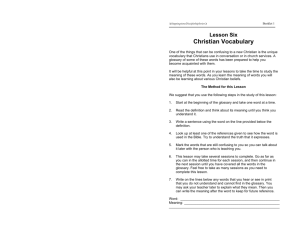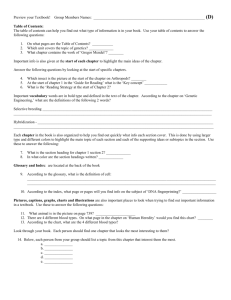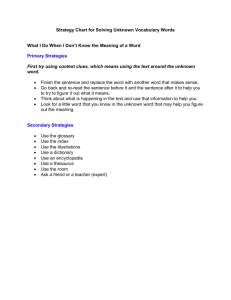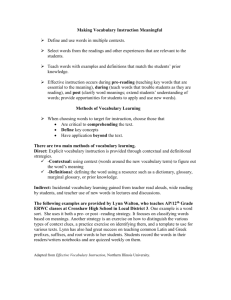Access The ability of patients or families or groups to reach or use
advertisement
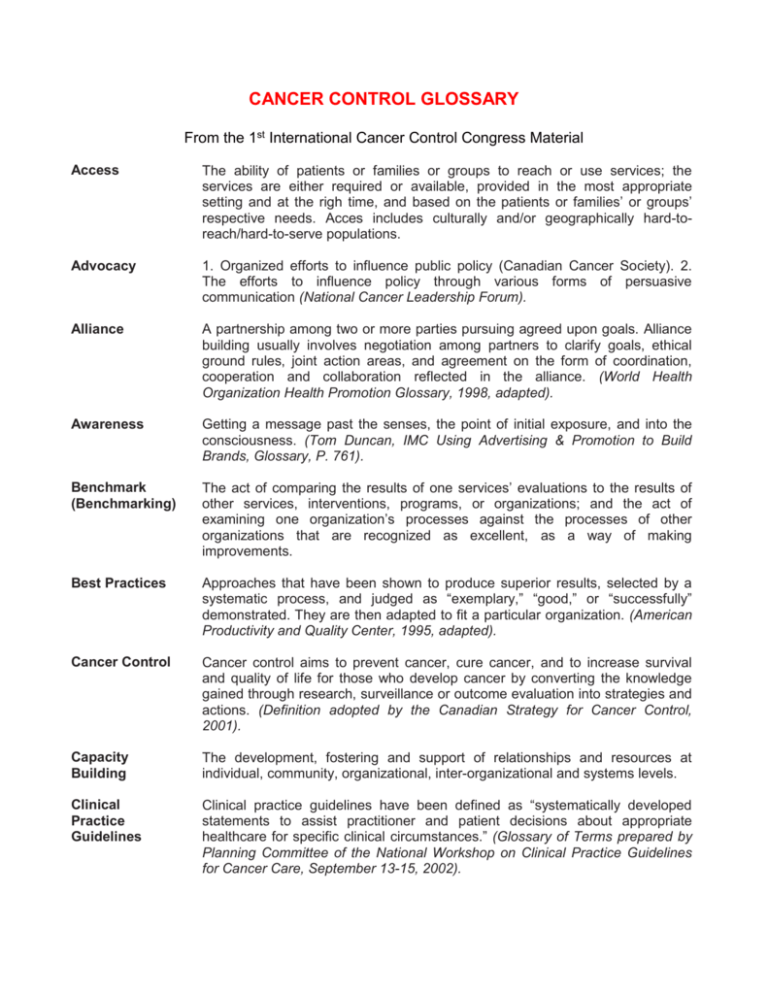
CANCER CONTROL GLOSSARY From the 1st International Cancer Control Congress Material Access The ability of patients or families or groups to reach or use services; the services are either required or available, provided in the most appropriate setting and at the righ time, and based on the patients or families’ or groups’ respective needs. Acces includes culturally and/or geographically hard-toreach/hard-to-serve populations. Advocacy 1. Organized efforts to influence public policy (Canadian Cancer Society). 2. The efforts to influence policy through various forms of persuasive communication (National Cancer Leadership Forum). Alliance A partnership among two or more parties pursuing agreed upon goals. Alliance building usually involves negotiation among partners to clarify goals, ethical ground rules, joint action areas, and agreement on the form of coordination, cooperation and collaboration reflected in the alliance. (World Health Organization Health Promotion Glossary, 1998, adapted). Awareness Getting a message past the senses, the point of initial exposure, and into the consciousness. (Tom Duncan, IMC Using Advertising & Promotion to Build Brands, Glossary, P. 761). Benchmark (Benchmarking) The act of comparing the results of one services’ evaluations to the results of other services, interventions, programs, or organizations; and the act of examining one organization’s processes against the processes of other organizations that are recognized as excellent, as a way of making improvements. Best Practices Approaches that have been shown to produce superior results, selected by a systematic process, and judged as “exemplary,” “good,” or “successfully” demonstrated. They are then adapted to fit a particular organization. (American Productivity and Quality Center, 1995, adapted). Cancer Control Cancer control aims to prevent cancer, cure cancer, and to increase survival and quality of life for those who develop cancer by converting the knowledge gained through research, surveillance or outcome evaluation into strategies and actions. (Definition adopted by the Canadian Strategy for Cancer Control, 2001). Capacity Building The development, fostering and support of relationships and resources at individual, community, organizational, inter-organizational and systems levels. Clinical Practice Guidelines Clinical practice guidelines have been defined as “systematically developed statements to assist practitioner and patient decisions about appropriate healthcare for specific clinical circumstances.” (Glossary of Terms prepared by Planning Committee of the National Workshop on Clinical Practice Guidelines for Cancer Care, September 13-15, 2002). Collaboration Collaboration is a process through which parties who see different aspects of a problem can constructively explore their differences and search for solutions that go beyond their own visions of what is possible. Collaboration involves joint problem solving and decision making among key stakeholders in a problem or issue. Consensus Substantial agreement. The degree of consensus that has been achieved is measured by asking participants to express one of the following positions: • I agree with the proposal • I can live with the proposal • I disagree, or remain undecided. Silence is not interpreted as consent. Education The act or process of guiding, instructing or training, providing direction and information. (Merriam-Webster Online Dictionary). Evidence Data and information used to make decisions. Evidence can be derived from research, experiential learning, indicator data, and evaluations. Evidence is used in a systematic way to evaluate options and make decisions. (See also the background document for ICCC Congress Session 1: The Science). Evidence-based Guidelines Evidence-based guidelines use a scientific method designed to minimize bias in the location, selection, synthesis, and interpretation and reporting of research results as the basis of clinical recommendations. (Glossary of Terms prepared by Planning Committee of the National Workshop on Clinical Practice Guidelines for Cancer Care, September 13-15, 2002.) (See also the background document for ICCC Congress Session 1: The Science). Guidelines Principles guiding or directing action. Health Promotion The combination of educational and environmental supports for action and conditions of living conducive to health. The actions may be those of individuals, groups or communities, of policymakers, employers, teachers or others whose actions control or influence the determinants of health. The purpose of health promotion is to enable people to gain greater control over the determinants of their own health. In health promotion, health is seen as a resource for everyday life, not the objective of living. Health is a positive concept, emphasizing social and personal resources, as well as physical capabilities. (Glossary of Terms prepared by WHO, Health Promotion Glossary, 1998). Healthy Public Policy Is characterized by an explicit concern for health and equity in all areas of policy, and by accountability for health impact. The main aim of healthy public policy is to create a supportive environment that enables people to lead healthy lives. Healthy public policies make healthy choices possible or easier for citizens. They make social and physical environments health enhancing. Indicator Performance measurement tool, screen, or flag that is used as a guide to monitor, evaluate, and improve the quality of patient service delivery, support services, leadership and partnerships. Indicators relate to structure, processes, and outcomes. Integrated Bringing together services, providers, and organizations from across the continuum to work together jointly so that their services are complementary to one another, are coordinated with each other, and are a seamless unified system, with continuity, for the patient. Linkages The manner or style of being united or connected in a formal way. (Webster, 2000). Lobby To conduct activities aimed at influencing public officials, especially members of a legislative body, on legislation. To promote or secure the passage of legislation by influencing public officials. (Merriam-Webster Online Dictionary). Morbidity The state of being diseased or ill. Mortality Rate The portion of a defined population that dies during a specific period. For cancer, this is expressed as the number of cancer deaths per 100,000 people per year. Network Individuals, groups and organizations working collaboratively in support of mutually agreed upon goals, principles and benefits. Outcomes (Results) Changes in health status, or the consequence of a service. Palliative Care The active total care of patients whose disease is not responsive to curative treatment; where control of pain, other symptoms and psychological, social and spiritual problems is of paramount importance. (World Health Organization, 1990). Partnerships Formal or informal working relationships between service providers or organizations, where services may be developed and provided jointly, or shared. Patients The patients, families, groups, and community being served by the organization. Prevention Disease prevention covers measures not only to prevent the occurrence of disease, such as risk factor reduction, but also to arrest its progress and reduce its consequences once established. Primary prevention is directed towards preventing the initial occurrence of a disorder. Secondary and tertiary prevention seek to arrest or retard existing disease and its effects through early detection and appropriate treatment; or to reduce the occurrence of relapses and the establishment of chronic conditions through, for example, effective rehabilitation. Public Health The science and art of promoting health, preventing disease, and prolonging life through the organized efforts of society. (World Health Organization Health Promotion Glossary, 1998, adapted). Quality of Life A measure of the extent a patient is free from pain or disability caused by disease, and the extent he or she is able to perform the normal functions of life unaided. Social Marketing A planned process for fostering societal change by influencing people’s attitudes, understanding and behavior. The discipline is based upon the principles and techniques that underlie the marketing of commercial products and services, adapted to a different marketplace, and to the promotion of different commodities (Mark Sarner & Janice Nathanson, Social Marketing for Business – a Manifest Communications Handbook, p. 1). Supportive Care/Cancer Rehabilitation Provision of the necessary services as defined by those living with or affected by cancer to meet their physical, social, emotional, nutritional, informational, psychological, spiritual and practical needs throughout the spectrum of the cancer experiences. (Fitch 1995, Ganz 1990 – Canadian Strategy for Cancer Control, 2001). Standards Desired and achievable level of performance against which actual performance can be compared. Surveillance Health Surveillance is the tracking and forecasting of any health event or health determinant through the collection of data, its implication, analysis and interpretation. Surveillance results in information and analytical products. (Canadian Strategy for Cancer Control, 2001). Treatments Specific treatment measures taken to cure cancer, or ameliorate its major effects. Cancer treatment includes surgery, radiation therapy, chemotherapy, hormone therapy, and pain relief measures.
